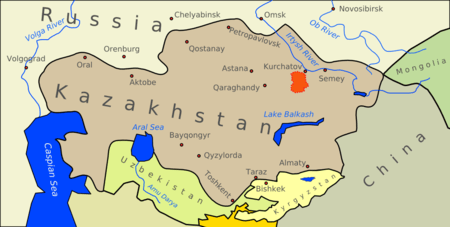Anti-nuclear movement in Russia
| Anti-nuclear movement |
|---|
 |
| By country |
| Lists |
The anti-nuclear movement in Russia began in the wake of the disaster at the Chernobyl reactor in 1986. During the most active phase of the anti-nuclear movement, from 1988 to 1992, construction of over 100 nuclear projects were prevented on the territory of the Soviet Union. Also, the economic troubles of the 1990s led to a reduction in the number of construction projects. This deprived the anti-nuclear movement of its raison d’être. At the same time, it too was affected by financial difficulties, in particular the lack of donations, which continues to be an issue today. Since the 2000s the Russian Government embarked on highly pro-nuclear policy, with plans to invest billions of dollars in developing the nuclear industry, which leaves the movement with big challenges.
History
Beginnings

During the most active phase of the anti-nuclear movement in the Soviet Union and Russia—from 1988 to 1992 over 100 nuclear projects were prevented on the territory of the Soviet Union. These were not just reactors, but also infrastructure projects linked to the planned power stations and other nuclear enterprises. This social activism succeeded in stopping nearly all of the nuclear plants under construction in Russia, either temporarily or permanently. After active protests, the planned construction of nuclear plants in Tatarstan and Bashkortostan, as well as of nuclear heating plants (Atomnye Stantsii Teplosnabzheniya—AST) in Gorky and Voronezh were stopped.[2]
2000s
The nuclear industry, struggling with liquidity problems, proposed that a new law be passed permitting the commercial import of spent nuclear fuel—the most dangerous kind of highly-toxic waste. It was claimed that this business could generate US$20 billion within ten years. The first reading of this draft law was held at the State Duma at the end of 2000, with more than 90 percent of lawmakers voting in favor.[3] After hundreds of public groups had engaged in just a few months of campaigning against this legislative proposal, more than 40 percent of Duma delegates changed their stance. Unfortunately, the law was accepted, but the opponents were only three votes short of the quorum needed to reject it. At least the environmentalists managed to secure a significant tightening of the procedure for importing nuclear waste compared to the first draft of the law. This was one of the reasons why the entire proposal for importing nuclear waste to Russia ultimately failed.
In August 2008, activists from all over Europe and Russia (about 50 persons) gathered in a 'tent city' near Nizhny Novgorod to participate in a 2-week anti-nuclear camp, which consisted of demonstrations and protests, music shows, workshops, movie shows & etc., to make the citizens of Nizhny Novgorod aware of a new NPP that's planned by Rosatom to be built in Nizhny Novgorod area.[4]
In autumn 2010, “EcoDefense!” played an important role in preventing a nuclear waste transport from the Rossendorf research reactor to Russia. Another example was the campaign against construction of the nuclear power plant in the area of Nizhny Novgorod. According to opinion surveys, about 70 per cent of the population were opposed to the nuclear plant (the survey was conducted before the disaster in Japan).
In the city of Murom, 20km from the site of the planned power plant, a local movement has been in existence for several years that has managed to delay construction of the plant. This movement was also responsible for organizing a demonstration of 5,000 people in autumn 2009- one of the largest protests against nuclear energy in Russia in the 21st century. The event was largely ignored by the Russian national media, although it was a unique event for the country.
References
- ↑ Togzhan Kassenova (28 September 2009). "The lasting toll of Semipalatinsk's nuclear testing". Bulletin of the Atomic Scientists.
- ↑ "The Russian Anti-Nuclear Movement", Alisa Nikulina, Russian Analytical digest, 101 (1), August 2011.
- ↑ "The Russian Anti-Nuclear Movement", Alisa Nikulina, Russian Analytical digest, 101 (1), August 2011
- ↑ Nuclear power- No Thanks, Anti-nuclear movement in Russia
